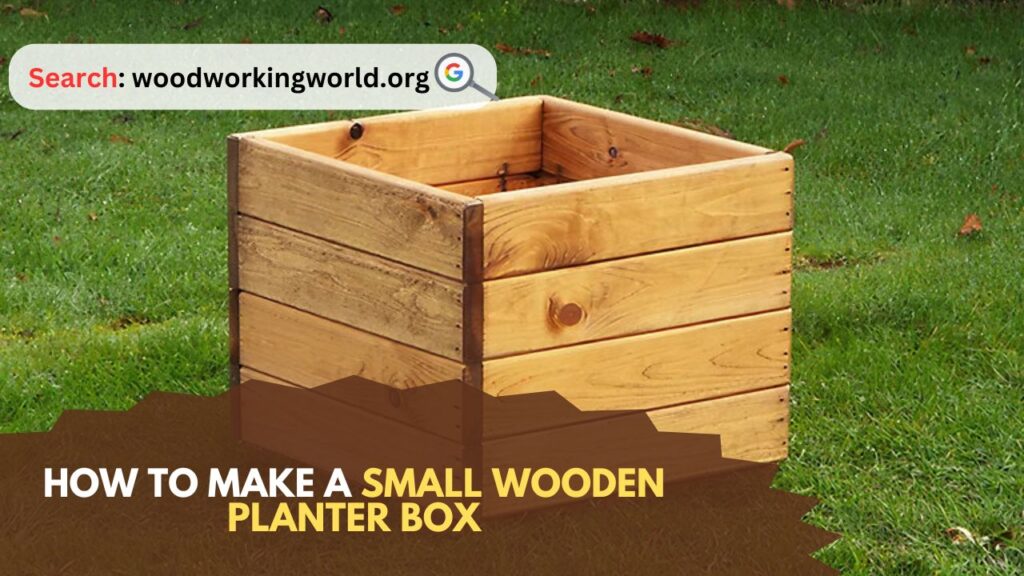Small Wooden Planter Box: Creating a small wooden planter box is a rewarding woodworking project that combines practicality with creativity. Whether you’re looking to enhance your garden, decorate your balcony, or even brighten up your living room with a touch of nature, a wooden planter box is a perfect choice. This guide will walk you through the process, step by step, ensuring that even beginners can craft a beautiful and functional planter box.

How to Make a Small Wooden Planter Box
Materials and Tools Needed
Materials
- Wood: Choose a durable type of wood suitable for outdoor use, such as cedar, redwood, or pressure-treated pine.
- Screws or Nails: Galvanized or stainless steel screws/nails are best to prevent rusting.
- Wood Glue: Waterproof wood glue for added stability.
- Lining Material: Landscape fabric or plastic lining to protect the wood from soil and moisture.
- Paint or Sealant: To protect the wood and add aesthetic value.
Tools
- Saw: Circular saw, miter saw, or hand saw.
- Drill: With appropriate drill bits.
- Screwdriver or Hammer: Depending on whether you’re using screws or nails.
- Measuring Tape: For accurate measurements.
- Sandpaper: To smoothen the wood.
- Clamps: To hold pieces together while the glue dries.
- Paintbrush: For applying paint or sealant.
- Safety Gear: Gloves, safety goggles, and a dust mask.
Step-by-Step Instructions
Step 1: Plan and Measure
Before you start cutting, it’s essential to have a clear plan. Decide on the dimensions of your planter box. A common size for a small planter box is 24 inches long, 12 inches wide, and 12 inches high, but you can adjust this according to your needs.
- Measure and Mark: Use your measuring tape and pencil to mark the wood pieces you will cut.
- Two pieces for the length: 24 inches.
- Two pieces for the width: 12 inches.
- Four pieces for the height: 12 inches.
Step 2: Cut the Wood
Using your saw, carefully cut the wood according to the measurements. Ensure the cuts are straight and even. If you’re using a circular or miter saw, a guide can help keep your cuts precise.
- Cut the Length Pieces: Two pieces at 24 inches each.
- Cut the Width Pieces: Two pieces at 12 inches each.
- Cut the Height Pieces: Four pieces at 12 inches each.
Step 3: Sand the Wood
Sand all the cut pieces to remove splinters and rough edges. This step is crucial for both the safety and appearance of your planter box.
- Sand the Edges: Focus on the edges where the cuts were made.
- Smooth the Surface: Sand the surfaces of the wood pieces to ensure a clean, smooth finish.
Step 4: Assemble the Frame
Start by assembling the four sides of the planter box.
- Position the Pieces: Arrange the two length pieces and the two width pieces in a rectangle.
- Apply Wood Glue: Apply a line of wood glue along the edges that will be joined together.
- Clamp the Pieces: Use clamps to hold the pieces in place while the glue dries.
- Drill Pilot Holes: Drill pilot holes through the width pieces into the length pieces to prevent the wood from splitting.
- Screw or Nail Together: Secure the pieces with screws or nails.
Step 5: Attach the Base
With the frame assembled, it’s time to attach the base of the planter box.
- Measure and Cut the Base: Measure the inside dimensions of the frame and cut a piece of wood to fit as the base.
- Sand the Base Piece: Smoothen the edges and surfaces of the base piece.
- Attach the Base: Apply wood glue along the bottom edges of the frame and place the base piece inside. Secure it with screws or nails, drilling pilot holes first if necessary.
Step 6: Add the Legs (Optional)
If you want your planter box to have legs for elevation, cut four pieces of wood to the desired height and attach them to the corners of the box.
- Cut the Legs: Four pieces at the height you desire, typically 4-6 inches for a small planter box.
- Sand the Legs: Smooth the edges and surfaces.
- Attach the Legs: Apply wood glue to the top of each leg and position them at the corners. Secure with screws or nails.
Step 7: Line the Planter Box
To protect the wood from moisture and soil, line the inside of the planter box with landscape fabric or plastic lining.
- Cut the Lining: Cut the lining material to fit the inside dimensions of the box.
- Attach the Lining: Staple or tack the lining to the sides and bottom of the box, ensuring it covers all interior surfaces.
Step 8: Finish the Planter Box
To enhance the durability and appearance of your planter box, apply a coat of paint, stain, or sealant.
- Choose Your Finish: Decide whether you want to paint, stain, or simply seal the wood.
- Apply the Finish: Using a paintbrush, apply your chosen finish according to the manufacturer’s instructions. Allow it to dry completely.
Tips for Success
- Choose the Right Wood: Opt for weather-resistant wood to ensure longevity, especially if the planter box will be used outdoors.
- Proper Drainage: Drill a few small holes in the base of the planter box for drainage to prevent waterlogging.
- Maintenance: Periodically check the planter box for any signs of wear or damage and reapply sealant or paint as needed.
- Customization: Personalize your planter box by adding decorative elements like trim, handles, or even stenciling designs.
Conclusion: Small Wooden Planter Box
Building a small wooden planter box is a satisfying project that can enhance your gardening experience and add a touch of rustic charm to your home or garden. By following these detailed steps and using the right materials and tools, you can create a beautiful, durable planter box that will serve you well for years to come. Enjoy the process and take pride in your handcrafted creation!
I hope this article on Small Wooden Planter Box has been helpful. If you have any further questions, please feel free to leave a comment below.
Video
